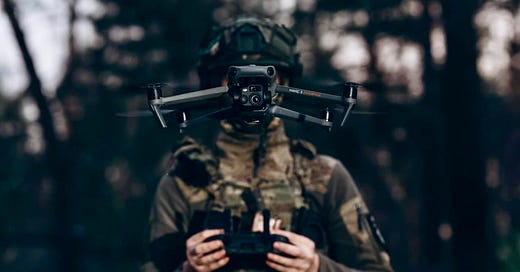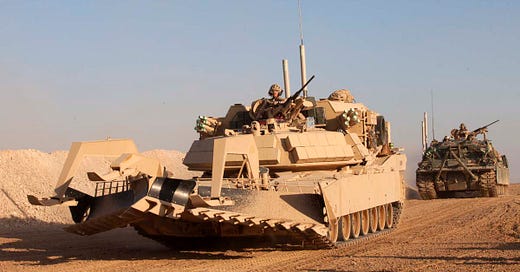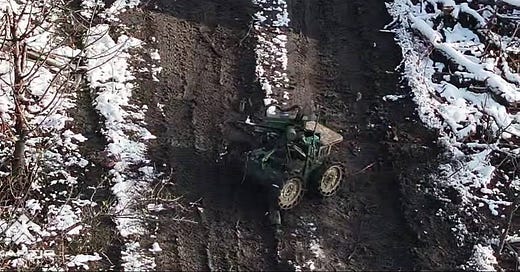
The Campaigns of Ukraine, Part 2
A May 2024 update on the various campaigns being conducted by Ukraine
This is part two of my May 2024 Ukrainian campaigns update. You can read the first part of this update, which included an examination of Ukraine’s land and air defence campaigns, here.
An Operational Strike Campaign
Ukraine is undertaking an operational strike campaign. The aim of an operational strike campaign should be to break down the coherence and unified action of multiple tactical actions across a theatre. It should also degrade the ability of undertaking future large-scale campaigns in the air, on the ground and at sea. Targets include heaquarters and communications facilities, operational logistics, reserves of forces not yet engaged or dedicated to particular combat actions, fires and air defence capabilities.
For Ukraine, their operational strike campaign appears to be aiming to degrade Russian fighting power in the south and east. This strike campaign is utilising long range missiles, including Storm Shadow and SCALP air-launched missiles, as well as maritime drones. Targets of this campaign include Russian logistic store locations, Crimean military targets, headquarters, and important transportation nodes.
Crimea in recent weeks has seen an increased tempo of attacks by the Ukrainians. This included the most recent Belbek airbase attacks, which destroyed aircraft and airbase infrastructure, and other attacks on radar and air defence sites in Crimea. As a recent UK intelligence assessment noted, these Crimea attacks have resulted in a degradation of Russian air defence over Crimea and have had a flow on impact on other Russian air force and air defence operations more broadly.
Attacks there have three key purposes: to reduce Russia’s ability to use Crimea as a launch location for missile and drone attacks; disrupt supply lines that transport fuel, ammunition and other classes of supply to the southern Ukraine battlefield; and degrading the Russian fleet operating in the region to ease the pressure on Ukrainian operations in the Black Sea, such as exporting grain.
Offensive maritime strikes are being enabled by a constantly evolving fleet of naval attack drones being developed and deployed by Ukraine. New generations of semi-submersible and stealthy maritime attack drones are being used and this has essentially made the western Black Sea and the Sevastopol fleet base untenable for the Russians. The Covert Shores site is an excellent resource on this growing fleet of semi-submersible Ukrainian attack drones. The latest update on this topic at Covert Shores, with the graphic from the site below, describes an impressive array of different drones.

One element of the operational strike campaign which may need to improve is operations to find, strike and destroy Russian combat formations, headquarters, fires and logistics that are not yet committed to combat. Destroying these second and third echelon forces, before they can be employed in combat against the Ukrainians must be a high priority. Ukrainian forces are already fighting at a disadvantage in manpower and firepower.
However, with US forbidding its weapons to attack targets in Russia, Ukraine is fighting this operational strike campaign with one hand tied behind its back. Apparently another request from Ukraine’s government has been made to the US administration to relax or remove this policy constraint.
A more robust operational strike campaign should aim to address this disparity, even if it comes at the cost of the spectacular, but possibly less effective, strategic strike campaign being undertaken by Ukrainian intelligence services and other elements of the Ukrainian armed forces against targets deep in Russia.
The Strategic Strike Campaign
Ukraine has been accelerating its program of strategic strikes against Russia in recent weeks. A strategic strike campaign should degrade the capacity of a nation to wage war and aims to influence the strategic decision-making of an enemy leader and principal advisors. The focus of a strategic strike campaign can include military, economic, informational, societal and diplomatic objectives.
Beginning the war with no strategic strike capability, the Ukrainians have constructed a robust targeting and strike complex that began in 2023 with multiple drone attacks on Moscow, and attacks on Russian airbases, deep inside Russia, including one that destroyed a Tupolev Tu-22M3 supersonic long-range bomber at the Soltsky-2 military air base. The Ukrainians have also conducted multiple attacks on the Kerch Bridge. These strikes are more political than military and aim to put pressure on Putin in front of the Russian people, and to answer for why he ‘can’t defend Russia’.
In the latest Ukrainian attacks, over 100 drones were used to strike multiple targets inside Russia and in Crimea on 17 May, which included energy and military sites. This demonstrates a growing sophistication in Ukraine’s targeting and strike operations.
Ukraine also has an ongoing campaign against Russian oil refining and export infrastructure. This is having an impact on the Russian energy sector, as the graphic below shows. However, whether it is capable of generating a decisive impact on the Russian economy and change Putin’s calculus about the war remains to be seen.
Ukraine’s Strategic Influence Campaign
Russian misinformation has been an important feature of this war, and it an art that the Russians have honed over the course of the war. Clearly they now believe they have the upper hand in the war and this is influencing their effort with themes that align with ‘inevitable Russian victory’ and ‘struggle against Western aggression’ being prominent and amplified by their Chinese allies.
We might also expect the Russians to also have a line of effort in their misinformation that is focussed on Zelenskyy’s legitimacy, given his normal term has just expired. The Russians, of course, will compare this to the ‘legitimate election’ of Putin in March this year.
As I wrote in one my articles after returning from Ukraine recently, Ukraine is not achieving the kind of strategic communications cut through that it achieved in the first year of the war. Then, President Zelensky was extraordinarily successful in using social media and appearances at national and multi-national events in gaining diplomatic, military, financial and humanitarian support for Ukraine. There are a multiple of possible explanations for this:
The absence of a clearly articulated of a clear Ukrainian theory of victory. Without a clear vision of what a Ukrainian victory looks like, which can be understood by Western politicians and publics, Ukrainian strategic influence activities will continue to struggle against Russian misinformation efforts.
The failure of the 2023 Ukrainian counter offensive.
The 2023-2024 mobilisation debate.
The Zelensky-Zaluzhnyi civil-military crisis.
The US congressional debate over assistance. This has resulted in Ukraine now being a partisan issue in the US and has seen some politicians reaching for any excuse not to support Ukraine.
The challenge of countering Russian messaging and global misinformation operations is profound. Russia has continued to evolve its strategic messaging through multiple means in the past two years. Russia appears to have a newfound confidence in its ability to wage war and about the trajectory of this war. The recent document issued by the patriarch of the Russian Orthodox Church provided clarified purpose for Russia’s attempt to subjugate Ukraine. It was a call to arms and provides an ideological foundation for the words and deeds of the Russian state henceforth.
Therefore, Ukraine needs to rejuvenate its strategic influence activities to better explain the importance of defending Ukraine, why Western support is vital, how Russian brutality must be stopped, and that Russian narratives about an inevitable Russian victory are wrong. It is an essential undertaking for 2024.
The Training Campaign
Training is at the heart of the existence of all good military institutions. Good combat units rest upon a regime of constant, up-to-date, and rigorous training. Combat leaders, over and above the normal regime of individual and collective training, must also engage in professional military education.
The counteroffensive in 2023 demonstrated some shortfalls in Ukrainian training. Individual and collective training needs constant updating, and adaptation based on battlefield trends. Ukraine must also ensure that there is alignment between training delivered in Ukraine by the Ukrainian armed forces schools, and that delivered by NATO nations across Europe.
At the same time, Ukraine must now use its new mobilization law to maximise its ability to reinforce depleted formation and to form new ones. President Zelensky has recently discussed for the formation of new brigades. The commander of Ukraine’s ground forces described the formation of ten new brigades, including four additional infantry brigades – the 156th, 157th, 158th and 159th Infantry Brigades. This will place an even larger burden on the training system. This is a major challenge for the coming months as Ukraine replaces its losses from the past six months and works to rebuild the offensive capacity of its ground forces.
Integrating the Campaigns in a Strategy of Corrosion
Perhaps the one thing that is more difficult than these campaigns is the overall integration of them within Ukraine’s military strategy for fighting the war against Russia. This strategy, which I have frequently described as a Strategy of Corrosion, is explored in more detail in this recent article for the Australian Journal of Defence and Strategic Studies.
Many different strategic decisions are required to prioritise each of these Ukrainian campaigns. Resources, personnel, munitions, and a variety of other commodities are needed for each. There will never be enough resources for all campaigns to have exactly what they need. For example, designating a ‘main effort’ for land campaigns is essential to ensuring the right levels of combat and support forces are available at the right place and time.
It is also important to ensure that each individual campaign does not have outcomes that compromise the aims and objectives of the other Ukrainian campaigns. Consequently, a degree of strategic programming and synchronisation is required to conduct all of these Ukrainian campaigns effectively.
Finally, these campaigns need to achieve strategic and political objectives. No military activity should exist outside a construct that ultimately achieves desired policy. This isn’t just a Clausewitzian dictate; it is how democracies must function during wars. All military activity must have a political aim, otherwise it is just pointless fighting.
Assessment
Ukraine’s progress in defeating Russian predations must be measured by more than the latest Russian offensive that receives a lion’s share of media reporting. A wide variety of campaigns are being executed, and are constantly evolving, which together aim to achieve a Ukrainian victory over Russia.
But as of May 2024, Russia has the strategic imitative in this war. It is using its advantages in size, firepower, and links to China, Iran, and North Korea to conduct a variety of ground and air offensives to attrit Ukrainian forces, keep them on the defensive, prevent the rebuilding of offensive capacity and project a strategic narrative around the world of ‘inevitable Russian victory’.
However, Russia has hardly maximised the opportunity that it was presented over the past six months to exploit a relatively weakened Ukraine. Even with Ukraine running desperately short on artillery and air defence munitions, having a civil-military crisis in command, and running very short on troops in many frontline formations, Russia has still only managed plodding and high casualty operations. Granted the Russians are doing this on seven different axes of advance, but the territorial gains (except for the Kharkiv offensive) have been minimal compared to the efforts that the Russians have made to achieve these additional parcels of Ukrainian territory.
Perhaps the one area where the Russians have made the most of the situation in the past few months is in their strike campaign against Ukraine’s energy sector. By stepping up the quantity of attacks, and evolving their tactics, at a time the Ukrainians are running short of air defence missiles, Russia has dealt a significant blow against Ukrainian power supplies.
The Russian window of opportunity is slowly closing. With the renewed flow of American military assistance, European nations stepping up their assistance (although more ‘stepping up’ is needed), and Ukraine beginning to exploit its recently passed mobilization law, the correlation of forces in Ukraine will change over the coming months. While there are no certainties in war, the Ukrainians are almost certain to be able to fend off current and near future Russian offensive operations.
The Ukrainians have also demonstrated the ability to expand their operational and strategic strike campaigns over the past few months. They will clearly continue these strikes. Although an emphasis on operational strikes is probably the best course of action to reduce Russian advantages in manpower and firepower, the Ukrainian desire to force Putin to change his strategic calculus by hitting his sources of foreign income at oil export facilities is likely to retain a high priority for the Ukrainian government.
Questions remain about the future of the ground war.
The real issue is whether Ukraine will be able to reform their training, build new formations, enhance their higher-level coordination of multiple formations, develop new offensive tactics and stockpile sufficient munitions and other military materiel to conduct offensive operations to retake captured territory in late 2024 or in 2025. That is the subject for another day. But it is sure to be focusing the minds of some on the Ukrainian general staff right now.

















Please explain the failure of the Ukrainian offensive. I surmised it was structured and influenced by NATO military doctrine. It did not account for entrenched Russian defenses and a lack of air superiority which seems to anchor NATO doctrine. Therefore doomed to failure with a circus over supplying Abram's tanks as icing on the cake.
So a paucity of F 16s (someday) and other equipment will continue the bleeding by Ukraine and reinforce the "inevitable" Russian victory and force capitulation on Ukraine.
Is the pending capitulation of Ukraine avoidable with anything short of a repeat of Nixon's emptying NATOs stockpile for the Israelis in 1973?
How about the war game results of Ukraine's fall followed by multiple Baltic states? Wake up Western leaders and rid us of Trumplicanism
On the Strategy of Corrosion: I think this is one of your keenest insights into the Ukraine situation. First, the use of corrosion as the "action" for the accomplishment of the strategic objective is loaded with the idea of time. No matter the domain of the contest, the mechanics of strategic corrosion require a sustained effort. That said, also implicit is the idea that there will be a breaking point, or decision point, where those efforts are harvested. (In other words, for this strategy to pay large dividends the proponent must be poised to take advantage of that opportunity.) Second, corrosion is environmental/inevitable. In the Ukraine context, that suggests that the corrosive actions taken by Ukraine would occur at points and places that (a) Russia has difficulty defending; or (b) Russia is overmatched. Put differently, these attacks are "dislocating" in that strengths are directed at weaknesses. This would seem to place a premium on the tactics to be utilized in each domain.
Corrosion as a strategy also appears (at least partly) case specific because corrosion assumes a certain deterioration and hollowness in Russian military/economic capabilities and political will. This assumption has been partly validated (withdrawal from Kyiv/the Kharkiv offensive/Prigozhin) and partly invalidated (Russian military and economic mobilization/no significant evidence of civilian dissent/resupply from Iran, NK, China). Regardless, Ukraine has few other attractive options given its relative disadvantages in population, manufacturing capacity, and the current balance of forces. The strategy is also likely attractive to many of Ukraine's allies, who are unwilling or unable to commit the resources that would afford Ukraine decisive personnel and material advantages on the battlefield.
Assuming this is Ukraine's strategy, we in the West should probably sequence allied efforts to (1) ensure Ukraine receives material sufficient to defend its current territorial integrity while simultaneously resourcing Ukraine's asymmetrical operational and srategic strike campaigns (including ending restrictions on where weapons can be used); (2) assist Ukraine in building the ground, air, and informational forces needed to take advantage of the opportunities created by its operational and strategic strike campaigns; and (3) immediately begin producing the quantities of war material that Ukraine will need to accelerate the number and tempo of corrosive actions and decisively defeat Russian national will. Most importantly, because the strategy of corrosion requires both patience and the ability to quickly take advantage of success, our decision makers must be primed to understand the strategy (and how to resource that strategy) in terms of timing.